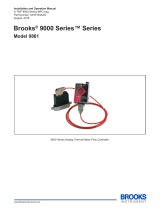
Additional information
SFC5500 SFC5400 SFC5460 SFC5300 SFC5330
Size W H L 29 91 115 mm 25 91 126 mm 29 51 105 mm 25 80 70 mm 25 66 48 mm
Weight 270 g 280 g 255 g 170 g 95 g
Electrical connector DB9 DB9 JST 4-pin DB9 JST 4-pin
Communication
interface
RS485
IO-Link
DeviceNet
RS485
Analog voltage
Analog current
IO-Link
DeviceNet
RS485
Calibration gas He, H, Ar, O, N,
air, CO, NO, CH non-aggressive gases
Dynamic range 1000:1 (100% to 0% of full-scale flow)
Pressure resistance up to 10 bar
Size depends on the fittings. See datasheet for exact dimensions.
Configured with dierent gasses/flow ranges: see MOQ in datasheet.
The gases used should be compatible with the wetted parts of the sensor. Typically, it should not be used with gases that attack
silicon, or sealing materials. A detailed overview of wetted materials is available as a table in the datasheet.
A soware tool is provided to manually calibrate the MFC for non-standard gases.
Definitions
Pressure drop is generated when a gas passes through a
mass flow controller. It is important to verify that at the
maximum required flow rate for a given gas, the inlet
pressure is higher than the pressure drop; otherwise the
desired maximum flow rate cannot be reached. Increas-
ing the valve size lowers the pressure drop, trading o
against the low flow accuracy/resolution. See the defini-
tion for valve size.
Valve size is selected by Sensirion based on the desired
gas and flow range. However, Sensirion can take into
account specific customer wishes, e.g. if a certain pres-
sure drop has to be achieved. Valve size selection is a
trade-o between low-flow control, pressure resistance
and pressure drop across the MFC. A smaller valve allows
for better flow control at low flow rates, but induces a
higher pressure drop across the MFC. On the other hand,
a large valve induces a lower pressure drop across the
MFC, but has worse flow control at low flow rates. In addi-
tion, smaller valves are more robust against dierential
pressure across the MFC (inlet vs outlet pressure).
Calibration gases can have dierent accuracies. For
example, the SFC5500 sensor is factory-calibrated with
air/N, He and CO, while the calibration of the remaining
gases is derived from a gas property simulation (model).
The accuracy for the calibrated gases is higher than for
those derived from a model. More information can be
found in the datasheet of each product or by contacting
your sensor expert. A soware tool is also provided to
manually calibrate the MFC for gases that are not included
in the library.
www.sensirion.com






